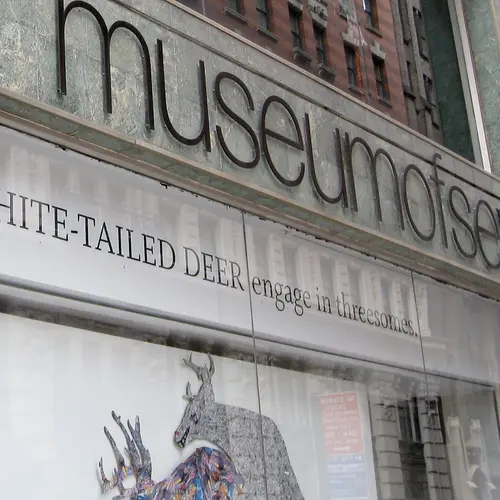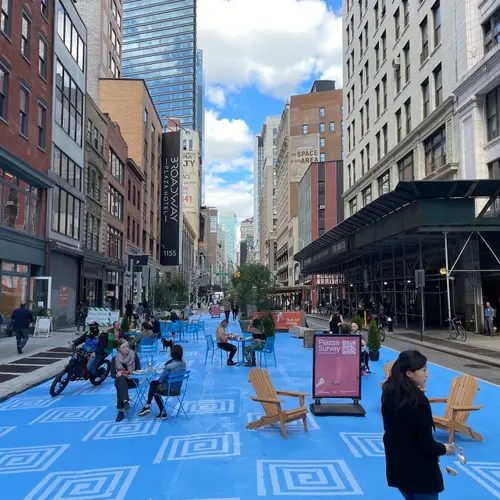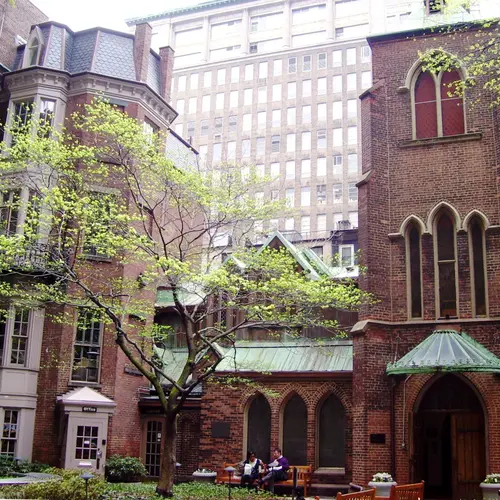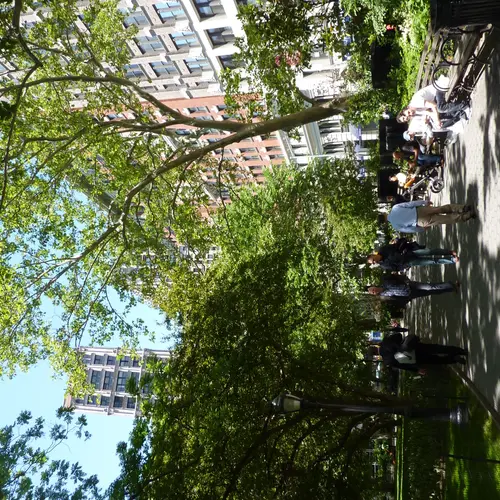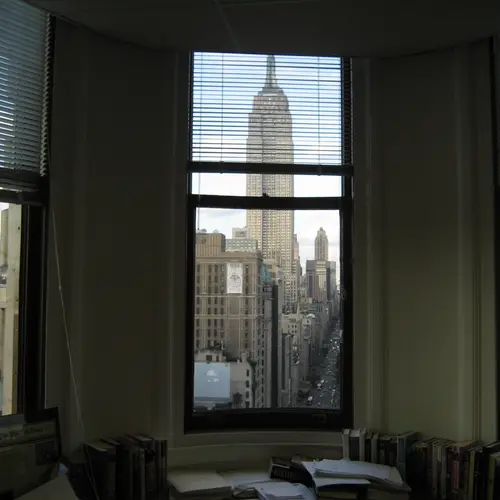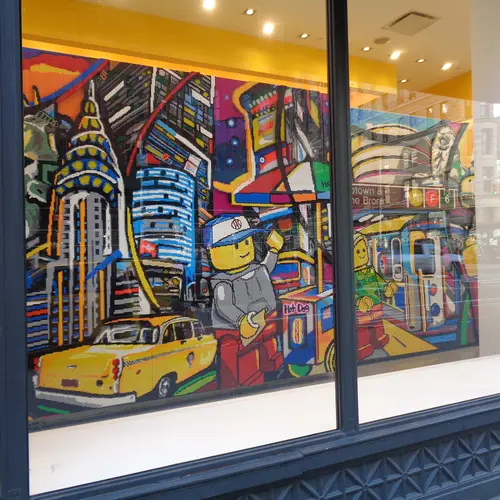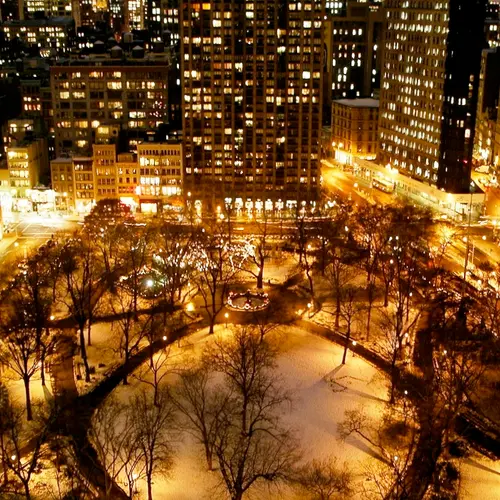Your guide to Nomad: A new chapter for a historic Manhattan neighborhood

Photo by Jeffrey Zeldman on Flickr
No matter how old or established they may be, New York City neighborhoods are in a constant state of change. With each new chapter, boundaries shift and new architecture and commerce arrive. The Manhattan neighborhood known as Nomad (for its location north of Madison Square Park) is a fine example. Nomad became a top residential choice, as well as an international dining destination and an all-around rising star, at the beginning of the 21st century. The neighborhood stretches from approximately 25th Street to 30th Street between Sixth and Lexington Avenues, but the bounty that surrounds it in the neighborhoods of Chelsea, Midtown, Union Square, and Gramercy knows no bounds.
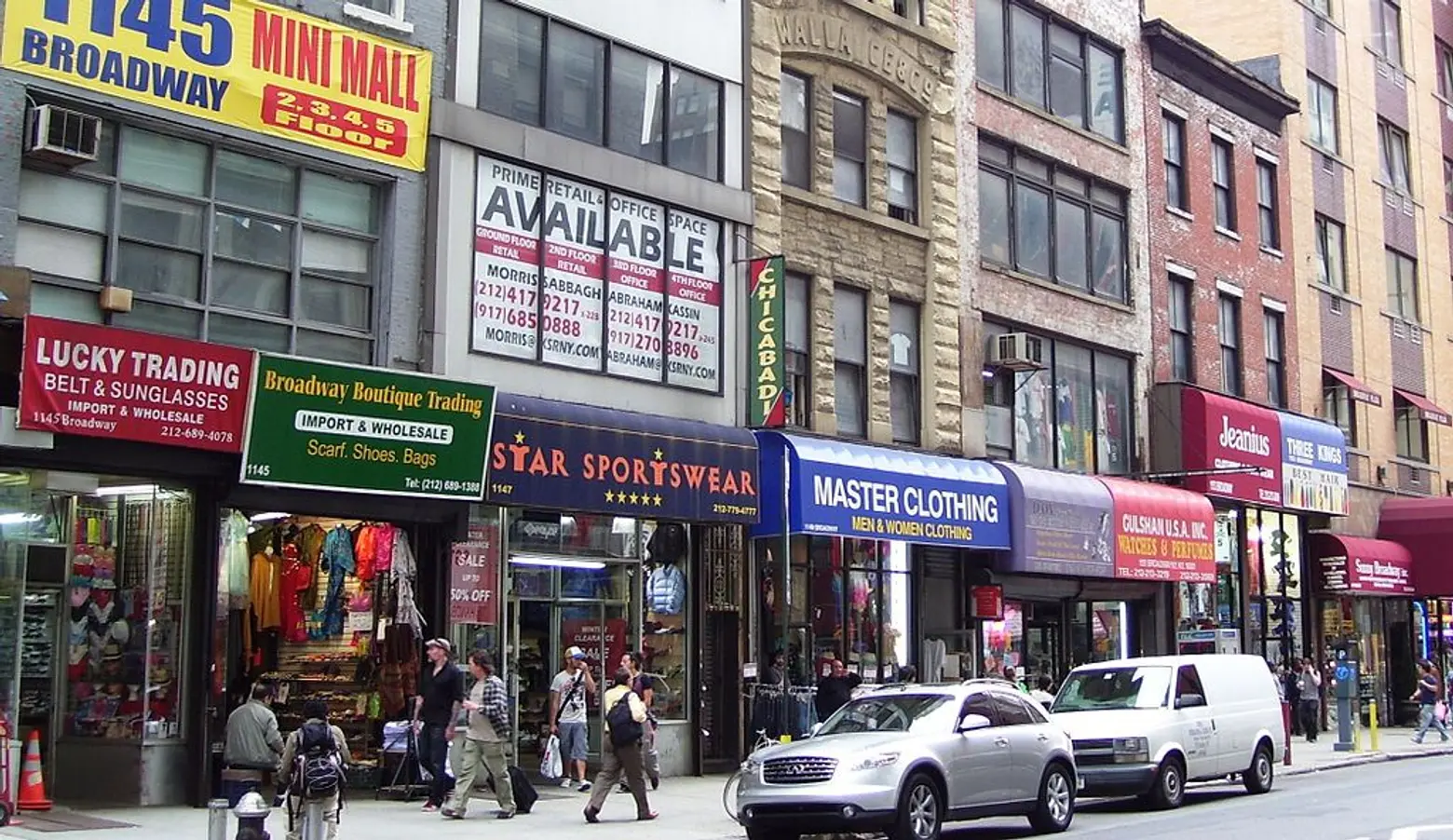 Broadway between 26th and 27th Streets, part of the current Madison Square North Historic District, via Wiki Commons
Broadway between 26th and 27th Streets, part of the current Madison Square North Historic District, via Wiki Commons
There’s a rich history here that includes the district’s days as “tin pan alley,” the songwriting hub for the nation and birthplace of American pop music. With the iconic Empire State Building rising just to the north, the neighborhood is architecturally symbolized by the distinctive Flatiron Building–it is often referred to as the Flatiron District–at its heart. Within, a historic district contains some of the city’s most interesting commercial buildings, many of which served their life as part of the city’s Gilded Age “ladies’ mile” shopping destination.
The world’s first modern art exhibition happened here in 1913 at the 69th Regiment Armory on Lexington Avenue, when the works of Degas, Manet, Duchamp, Matisse, and Picasso rocked the international and New York art scenes.
 Photo via CityRealty
Photo via CityRealty
The neighborhood rose from a city-wide period of stagnation in the later 20th century, in part with a hand from celebrated young restaurateur Danny Meyer, who opened the first Shake Shack as a hot dog stand in Madison Square Park. The ubiquitous burger mecca now has over 400 locations globally, but it’s often said that Meyer, who followed fast-food fame with some of the city’s best-known fine dining establishments, including Gramercy Park Tavern, Blue Smoke, and Eleven Madison Square Park, put the neighborhood firmly on the international map. Flatiron and Nomad combined are home to no fewer than eight Michelin-starred restaurants.
 Rendering of Madison House at 15 East 30th Street courtesy of DBOX
Rendering of Madison House at 15 East 30th Street courtesy of DBOX
As one of Manhattan’s most important interior design trade destinations, the Nomad Design District is home to the Manhattan Center for Kitchen and Bath as well as flagship designer showrooms offering contemporary and modern furniture and fixtures from Herman Miller, Vitra, Poliform, B&B Italia, DDC, Minotti New York, and Kohler among many others.
In the past two decades, Nomad has attracted residents to newly-minted residential towers like the supertall 262 Fifth Avenue, Madison House, 277 Fifth Avenue, 128 East 28th Street, 30 East 31st Street, The Ritz Carlton Nomad and Rose Hill at 30 East 29th Street and historic conversions at 212 Fifth Avenue (Jeff Bezos owns several units) and the Whitman Mansion at 21 East 26th Street. Read on for an introduction to the Manhattan neighborhood’s newest chapter.
Things to see and do in Nomad
 Photo via Wikimedia cc
Photo via Wikimedia cc
Where to eat and drink
Shake Shack
This now-ubiquitous fast-casual burger chain was born in 2000 as a hot dog stand in Madison Square Park. Restaurateur Danny Meyer, as part of an effort to improve the park, which had become neglected, ran the cart out of the kitchen of his fine-dining establishment Eleven Madison Park. The cart remained in operation for three years, growing in popularity, and was granted a permanent kiosk permit in 2004.
Along with expansion to burgers, fries and, yes, milkshakes, the business became one of the country’s fastest-growing chains, becoming a publicly-traded company in 2014. There are now over 400 locations worldwide; then and now, it has been a go-to for a burgers-and-more menu that includes the famous ‘Shroom Burger with additions like White Truffle keeping things fresh.
Eataly
This lively Italian marketplace got its start in Italy in 2007 in an old vermouth factory. The concept has expanded worldwide, and Mario Batali and Lidia and Joe Bastianich partnered to open the 50,000-square-foot New York City outpost at 200 Fifth Avenue in 2010, offering all things culinary and Italian, from pizza and pasta to cooking classes and a wealth of grocery items from cheese to olive oil and beyond.
Eleven Madison Park
This triple-Michelin-starred American restaurant, created by neighborhood booster and restaurateur Danny Meyer and since sold to chef Daniel Humm, is considered one of New York City’s–if not the world’s–finest dining establishments. Located inside the Metropolitan Life North Building at 11 Madison Avenue, it occupies a beautiful Art Deco space overlooking Madison Square Park. The restaurant is known for its tasting menu as well as its efforts in providing food for New Yorkers experiencing food insecurity, in partnership with Rethink Food.
 Photo credit: Francesco Sapienza
Photo credit: Francesco Sapienza
Gramercy Tavern
Among the first of restaurateur Danny Meyer’s neighborhood offerings, this Michelin-starred fine-dining destination with a celebrated prix-fixe-only menu has been topping “best-of” lists since it opened in 1994.
 Photo credit: Nick Johnson
Photo credit: Nick Johnson
Koloman
Located in the Ace Hotel, a celebrated neighborhood anchor, this contemporary French restaurant features a mix of Parisian creativity and Viennese tradition.
 Photo credit: Lou Stejskal via Flickr
Photo credit: Lou Stejskal via Flickr
Cosme
Cosmé offers elevated cuisine inspired by Mexican flavors while working with local, seasonal ingredients from the Hudson Valley and surrounding regions.
Bourke Street Bakery
Now with locations throughout the city, this Aussie-born bakery serves up its specialty, organic sourdough, to a loyal and growing fan base of bread lovers along with classic meat pies, sausage rolls, artisan breads, cookies, cakes, fresh sandwiches, and more.
Planta Queen
As part of the popular Planta group of vegan eateries, PLANTA Queen offers all-plant-based vegan dining in Nomad. Seasonal ingredients inform a menu built around staples like Spinach Shiitake Dumplings, Crispy Gyoza, Potato Truffle Dumplings, and Sweet Corn Dumplings. The restaurant’s Bang Bang Broccoli has a cult following, as do plant-based vegan sushi and noodle dishes.
Atoboy
The four-course $75 prix-fixe menu at this Korean restaurant with a casual vibe features ingredients like octopus, sea urchin, and scallops. Innovative and inspired food and a cavernous industrial space make for a unique dining experience.
Atomix
This two-Michelin-starred Korean establishment is a celebration of unique cuisine from husband-and-wife team Junghyun and his Ellia Park, who first opened Atoboy around the corner. To make your way into this semi-hidden spot, you’ll need to ring an unmarked doorbell to summon a restaurant employee, who will escort you through an upstairs bar and into a downstairs lounge where a dining counter awaits. A $175 tasting menu has a reputation for being worth the journey for dishes that range from simple to complex, small to substantial.
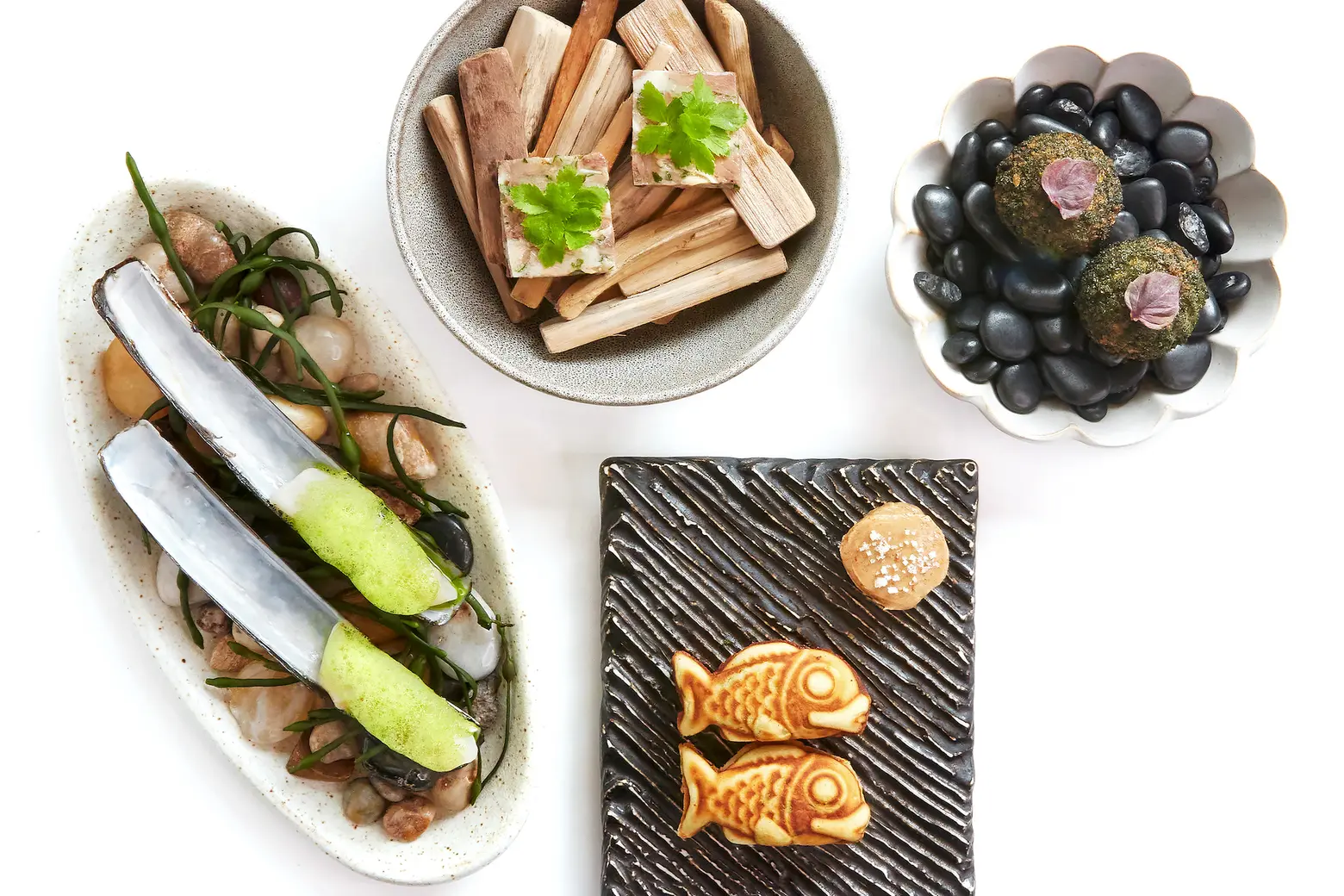
Photo courtesy of LittleMad
LittleMad
This Korean spot from the team behind Atoboy and Her Name Is Han serves French and Korean-inspired small plates in an industrial space with an open kitchen and a casual atmosphere. It’s a great dining adventure that might be just a little mad–see what they did here–in a tiny space that’s perfect for sharing with friends.
Her Name Is Han
Is it any surprise that a cutting-edge culinary neighborhood that borders Manhattan’s Koreatown would be filled with Korean–and Korean-inspired–restaurants? More the former than the latter, Her Name Is Han serves homestyle Korean food in a cozy, apartment-like space, and always gets it right.
 Photo credit: Jason Varney
Photo credit: Jason Varney
Zaytinya
Located in the Ritz-Carlton Nomad, a significant, buzzy new-ish addition to the neighborhood’s growing collection of luxury residences and destination hotels, José Andrés’ 140-seat street-level restaurant features a mezze menu inspired by Turkish, Greek, and Lebanese cuisines in a mod-meets-Mediterranean setting courtesy of David Rockwell’s Rockwell Group. The Nomad location is the second for Zaytinya, which first opened in 2002 in Washington, DC.
KazuNori: The Original Hand Roll Bar
This hand roll bar from the famed sushi chef Kazunori Nozawa and the Nozawa Group, the folks behind the equally famed Los Angeles restaurant Sushi Nozawa, is not a perfect place to linger over dinner. But it’s a great place to grab the pencil and paper provided and order up some rolls, reasonably priced, freshly-made, satisfying, and delicious. Come before 7 p.m., though–or you’ll find that lots of other people–understandably–have the same idea.
Nonono
If you want to order a taste of practically everything on the menu and not go broke, Nonono is the place to do it. Japanese small plates are the fare at this spot from the people behind Her Name is Han Korean restaurant. The menu is endless, the prices are reasonable, and items like the Rainbow Roll, Yuzu Kosho Nori, and Tamago Bacon are sizzling and satisfying.
 Photo via Wikimedia cc
Photo via Wikimedia cc
Hill Country Barbecue
Downtown Austin in Midtown Manhattan. Hill Country Barbecue offers Central Texas barbecue favorites, bourbon, cocktails, and live music with counter-style ordering and lots of southern hospitality.
 Photo Credit: Alice Gao
Photo Credit: Alice Gao
Marta
This pizza restaurant in The Redbury New York hotel offers the rustic cuisine of Rome using fresh, local produce. In addition to crave-worthy thin-crust pies, the lively space turns out family-style roasts, grilled seafood, and vegetables for neighborhood folks and visitors alike.
 Photo Credit: Seven Grams Caffe
Photo Credit: Seven Grams Caffe
Seven Grams Caffe
With a name that pays tribute to the perfect espresso shot, which contains exactly seven grams of ground premium coffee, this independent cafe with three Manhattan locations is known for its gooey chocolate chip cookies and other baked delights.
Maki Kosaka
This casual offshoot of Michelin-starred West Village omakase sushi spot Kosaka is a more “approachable” version in the form of a sushi hand-roll restaurant. You can still get the omakase experience with the makimono set, and there are maki roll combo options so you can assemble your own selection as well.
Where to shop

Photo of the Nomad Piazza in October 2021 courtesy of the Flatiron NoMad Partnership
Nomad Piazza
As part of the city’s Open Streets initiative, this pedestrians-only strip could be called the Nomad version of a mall. You’ll find an opportunity to sample the wares from standout restaurants, find fierce fashions and vintage treasures, and more. Stop in at the Ace Hotel Lobby Bar for an instant intro to the neighborhood.
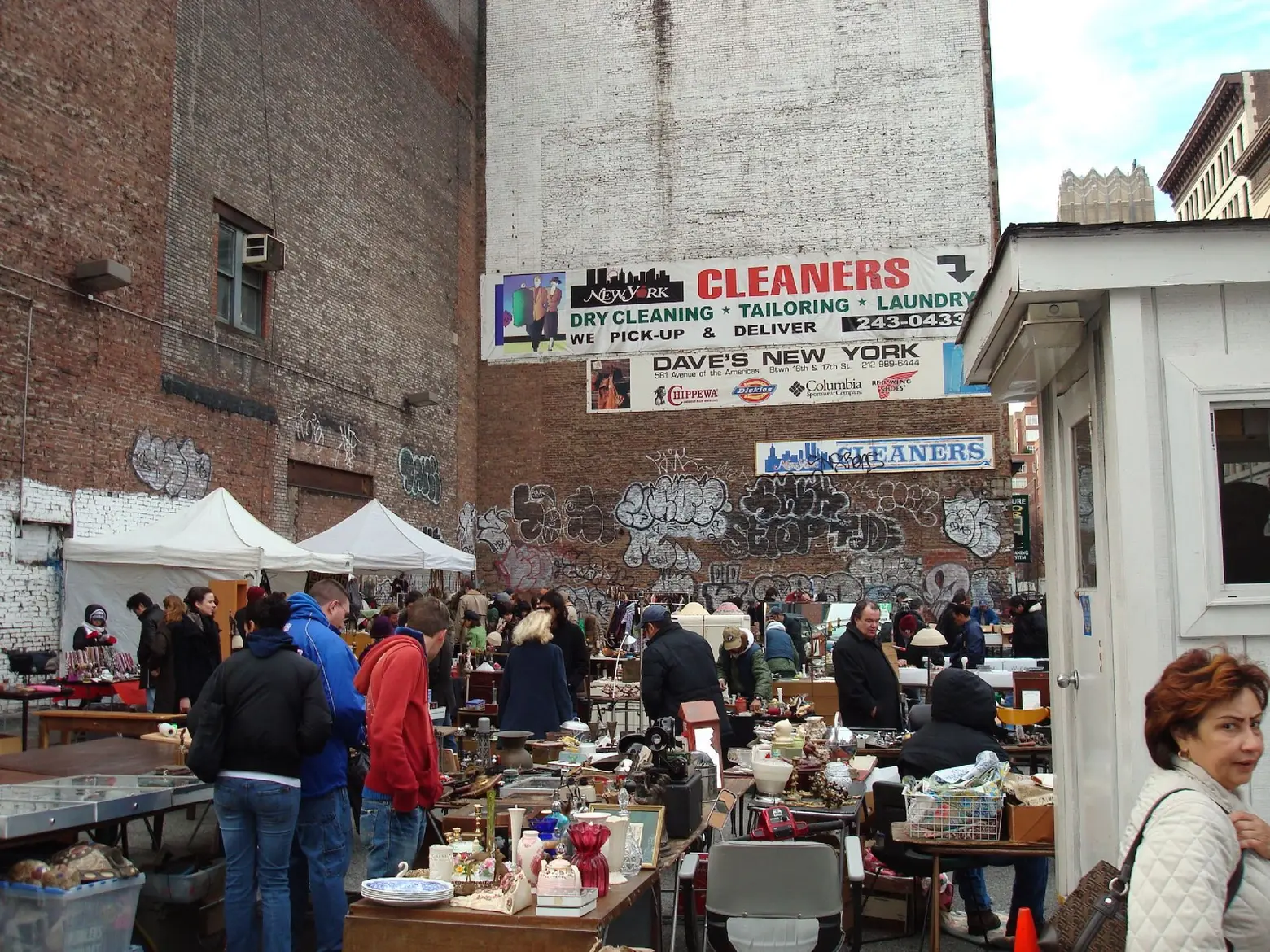 Photo credit: Shannon McGee on Flickr
Photo credit: Shannon McGee on Flickr
Chelsea Flea
We’d be remiss not to mention the long-running (since 1976) Chelsea Flea, reborn in 2020 under the Brooklyn Flea umbrella. The outdoor, every-weekend flea market has more than 50 antique and vintage dealers, some from its previous incarnation, some new.
 Image courtesy of Phil Roeder on Flickr
Image courtesy of Phil Roeder on Flickr
Union Square Greenmarket
Just to the south in Union Square, this is the city’s longest-running and best-known farmers’ market. You’ll find food, flowers, crafts, and much, much more every Monday, Wednesday, Friday, and Saturday. At holiday time it’s a wonderland of gifts and holiday decor.
Rizzoli Bookstore
Rizzoli Bookstore has been a favorite for its beautiful photo-based coffee-table books since 1964. You’ll find that beauty echoed in the surroundings at the Nomad store, where you can browse illustrated subjects like architecture, interior design, fashion, fine arts, and food.
Le Labo Fragrances
This high-end bath and body products shop is known for its hand-blended, personalized perfumes, candles, shampoo, lotion, and more, many of which are available in this heavenly-smelling space.

Photo courtesy of Maison 10
Maison 10
This unique store offers customers a curated range of beautifully-designed items that support brilliant causes. A fascinating collection of accessories, art, beauty products, and home goods by innovative designers is constantly changing but always interesting.
Dover Street Market
This designer multi-brand retail market first opened in 2004 on Dover Street, in Mayfair, London, launched by Rei Kawakubo of the Japanese fashion label Comme des Garçons. The market opened its New York City outpost in 2013. You’ll find all Comme des Garçons brands, here, of course, as well as high fashion and streetwear brands from Balenciaga, Gucci and Loewe to Golf Wang, Stüssy, and Supreme.
Project Gaia NYC
Located in a historic 3,000-square-foot building, this multi-brand concept store from Maison de Papillon calls itself “the new way to shop” for sustainable and ethical products in lifestyle, beauty, home, and apparel.
Yeohlee
After studying fashion at the Parsons School of Design, Yeohlee Teng established her own house, YEOHLEE, in 1981. The label is still a favorite among an international following of fashionistas since 1981, and she’s still featuring her locally-made collections from the Nomad flagship store, located within walking distance of the Garment District.
Buffalo Exchange
As pioneers in the retail fashion industry, this hip chain buys, sells, and trades on-trend vintage and used apparel and accessories. With locations in hot neighborhoods throughout the city, it’s one of the few stores you can only visit in person. This location is a favorite with FIT students.
Alo Yoga
More than just a fitness gear chain, Alo has downward-dogged its way to the top of the fitness brand pile with online and in-person classes as well as trendy workout fashions and accessories. The Flatiron location offers studio classes and a plant-based rooftop restaurant, Sutra, on the fourth floor for the complete Alo experience.
 Image via Wikimedia cc
Image via Wikimedia cc
LEGO store
A LEGO store doesn’t need much introduction; this flagship location offers a replica Flatiron Building and plenty of play areas. In addition to selling a variety of 500 LEGO sets, LEGO-inspired items and custom New York-inspired models, the store also hosts LEGO club meetings and free monthly mini-model build sessions.
 Image courtesy of NYC X Design
Image courtesy of NYC X Design
Nomad Design District
As one of Manhattan’s major interior design districts, the Nomad Design District is an international design destination with some of the world’s best high-end furniture showrooms, art galleries, architectural firms, and interior design studios. The neighborhood is home to the trade mecca Manhattan Center for Kitchen and Bath as well as showrooms for Natuzzi Italia, Molteni Group, Duravit, DDC, Minotti, Moooi, the Kohler Experience Store, and many more.
Events and culture

Image via Wikimedia cc
The National Museum of Mathematics
This award-winning hands-on museum attracts thousands of visitors annually. “Mo Math” highlights the role of mathematics in illuminating the patterns and structures all around us with dynamic exhibits, galleries, and programs designed to spark curiosity about the wonders of mathematics in visitors of all ages.
 Image via Wikimedia cc
Image via Wikimedia cc
Museum of Sex
The name is more X-rated than the actual museum, whose mission is to “preserve and present the history, evolution and cultural significance of human sexuality.” “Mo Sex” offers exhibitions, publications, and programs that appeal to a wide audience, encouraging public enlightenment, discourse, and engagement, with help from world-renowned design firms.
 Image courtesy of Eden, Janine, and Jim via Flickr
Image courtesy of Eden, Janine, and Jim via Flickr
The Cutting Room
This classic rock club formerly housed on West 24th Street reopened at the beginning of 2013 in its new location at 44 East 32nd Street between Park and Madison, building on a decade of history that includes top performers like John Mayer, Lady Gaga, Sting, Sheryl Crow, and David Bowie. Insider tip: Actor Chris Noth is a co-owner, along with original owner Steve Walter.
 Photo credit: The Museum at FIT via Flickr
Photo credit: The Museum at FIT via Flickr
The Museum at FIT
The Fashion Institute of Technology is one of the world’s most prestigious design schools. The Museum is known for its innovative, award-winning exhibitions, such as “Fresh, Fly, Fabulous: 50 Years of Hip Hop Style,” as well as a permanent collection of more than 50,000 garments and accessories dating from the eighteenth century to the present.
 Image via Wikimedia cc
Image via Wikimedia cc
Fotografiska
This photography museum is a destination that offers a chance to discover world-class photography through eclectic programming with a commitment to local culture. From live music and performance to discussions and dinner, the museum invites the community to gather, discuss, share, and celebrate photography. The Roman and Williams-designed Veronika restaurant, hidden away on the second floor, offers a unique space for late-night conversations over a shared meal. Next door in a former 19th-century chapel, Chapel Bar is an after-dark lounge, open for evening cocktails–and occasional performances and live events–from 6 p.m. until late.
Parks and public places to gather
 Photo credit: Jeffrey Zeldman via flickr
Photo credit: Jeffrey Zeldman via flickr
Madison Square Park
This two-acre green space in the midst of Manhattan has been public land since 1686; some credit the park’s southwest corner as the spot where modern baseball was born. Surrounded by landmark architecture and an ever-changing collection of businesses, the park serves as a public garden, a playground, an exhibition space, a dog park, a food court, and a gathering spot. The community-funded park is managed by Madison Square Park Conservancy.
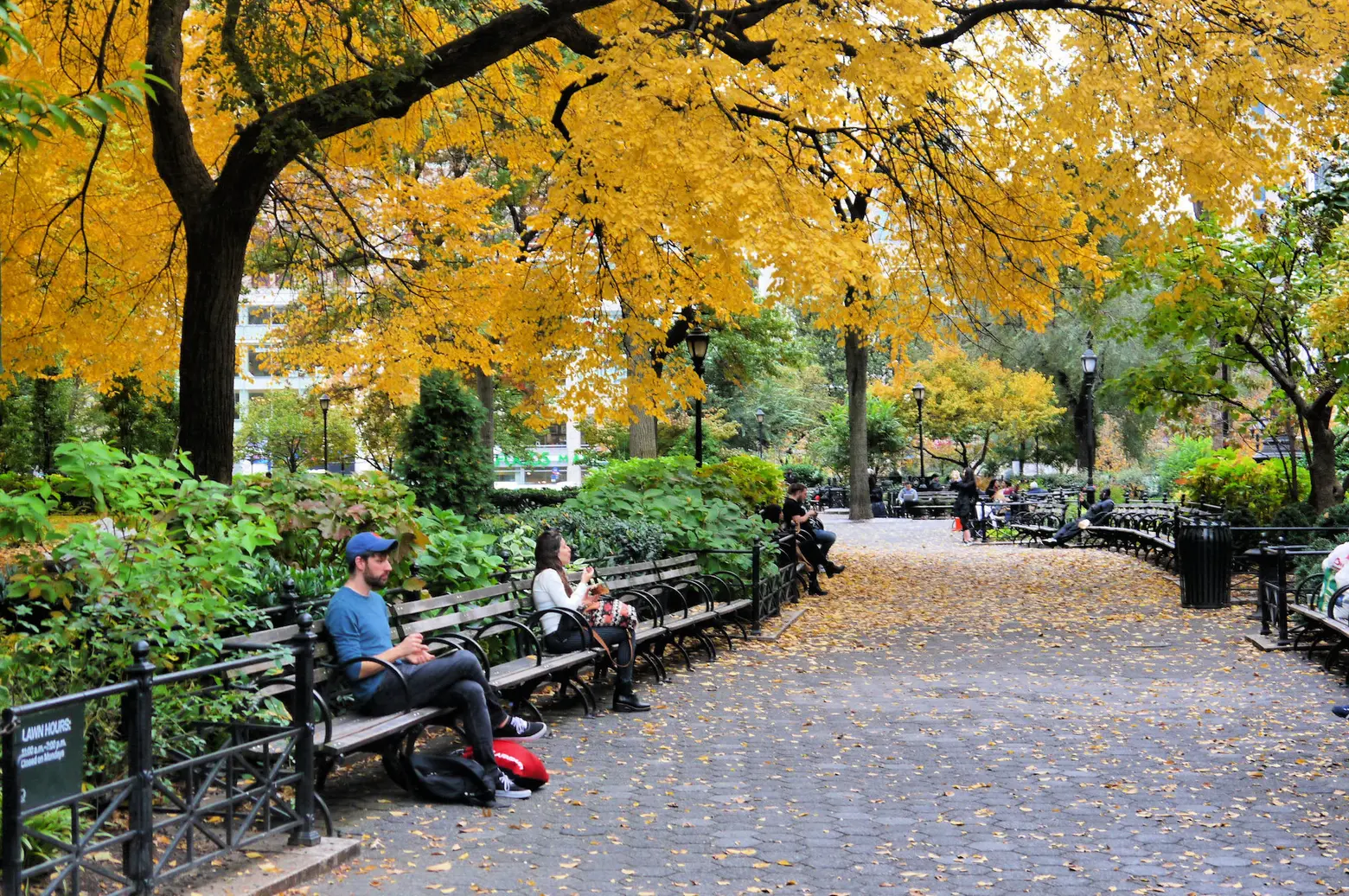 Photo credit: Eden, Janine and Jim on Flickr
Photo credit: Eden, Janine and Jim on Flickr
Union Square Park
Founded in 1839, this iconic communal space was redesigned in 1872 by Frederick Law Olmsted and Calvert Vaux, and has since hosted too many community events to count, from the first Labor Day parade in 1882 to workers’ rallies in the 1930s to the first Earth Day in 1970 to the celebrated ongoing Greenmarket and holiday markets. This historic intersection of Broadway and the former Bowery Road is maintained by the New York City Department of Parks and Recreation. Within its borders are statues honoring George Washington, Abraham Lincoln, Mohandas Gandhi, and Marquis de Lafayette.
Notable neighborhood highlights
 Photo Joan Gramatte on Wikimedia
Photo Joan Gramatte on Wikimedia
Flatiron Building
This instantly-recognizable triangular 22-story, 285-foot-tall landmark at 175 Fifth Avenue, designed by Daniel Burnham and Frederick P. Dinkelberg, was completed in 1902, anchoring the spot where Fifth Avenue, Broadway, and East 22nd Street meet. Its name recalls an old-fashioned cast-iron clothes iron. The building was developed for the Fuller construction company as its headquarters. A “cowcatcher” retail space and a one-story penthouse were added shortly after the building opened. Now owned by the Sorgente Group of America, the building just got a $50 million renovation.
Ace Hotel
This boutique hotel is the New York City flagship of the popular Ace chain of now-international hotels, which transformed the American hotel model from a stodgy and generic, if luxurious, amenity to a hip, communal experience. The hotel has been home to several top restaurants, and its bar and performance spaces are both destinations and tourist attractions. The intimate street-level bar invites any and all to sink into its leather sofas with a drink or a bite from the all-day menu.
69th Regiment Armory
The world’s first modern art exhibition happened here in 1913, when the works of Degas, Manet, Duchamp, Matisse, and Picasso rocked the international and New York art scenes. Since then, the Armory has been host to everything from roller derby matches to New York Knicks home games to Soundgarden concerts and Victoria’s Secret fashion shows. The historic landmark returned to its roots in 1994, hosting the annual Downtown Art Fair; the important international art fair has kept the Armory Show name but moved to the Javits Center in 2021.
 Photo via Wikimedia cc
Photo via Wikimedia cc
Historic churches
For history and architecture buffs, the neighborhood is home to several architecturally significant and interesting churches in addition to its historic commercial buildings. The Church of the Transfiguration, built in 1850 in the early Neo-Gothic style, is also recognizable by the public garden in front; though the current Marble Collegiate Church was built in 1854, its congregation was first founded in 1628 as the Collegiate Reformed Protestant Dutch Church, one of the oldest Protestant churches in North America. Norman Vincent Peale, the author of “The Power of Positive Thinking,” served as the senior minister here from 1932-1984.
 Rendering of 30 East 31st Street by The Neighbourhood, courtesy of Morris Adjmi Architects
Rendering of 30 East 31st Street by The Neighbourhood, courtesy of Morris Adjmi Architects
Where to live
In the past two decades, Nomad has attracted residents to newly-minted residential towers like the supertall 262 Fifth Avenue, Madison House, 277 Fifth Avenue, 128 East 28th Street, 30 East 31st Street, The Ritz Carlton Nomad and Rose Hill at 30 East 29th Street and historic conversions at 212 Fifth Avenue (Jeff Bezos owns several units) and the Whitman Mansion at 21 East 26th Street.

Credit: THREE MARKS
277 Fifth Avenue
Even if it weren’t Nomad’s tallest tower, Rafael Viñoly’s 55-story Nomad tower at 277 Fifth Avenue would attract plenty of attention for its pared-down yet distinctive facade and double-height, open-air loggias that look as if they’re carved out of the building’s uppermost corners. Luxury is in evidence: The 720-foot condominium tower is topped by four penthouses, one of which was recently listed for $24 million. The building is the second tallest on Fifth Avenue and is considered the follow-up skyscraper to Viñoly’s supertall 432 Park Avenue to the north.
Interiors at the tower come courtesy of Jeffrey Beers, who opted for a neutral palette featuring natural finishes like white oak in the kitchen and marble in the bathrooms. Beers also designed a two-floor amenity space including a lobby library with a double-height bookcase wall, an entertainment suite featuring a bar and private dining room with a catering pantry, a fitness club opening onto the furnished Fifth Avenue Terrace, a games lounge, and a kids’ club.
Sales prices for units in the tower average at $3,075 per square foot and range from a $1.8 million one-bedroom to the aforementioned penthouse for nearly $25M.

Rendering courtesy of CityRealty
128 East 28th Street
The condominium building at 128 East 28th Street brings a modern-yet-contextual aesthetic to the Nomad neighborhood. Designed by TRA Studio for Sinha Development, the 80-foot-tall structure includes ground-floor retail space. Floor-to-ceiling windows form the understated contemporary facade; within the boutique building are only two apartments per floor, adding up to 10 two-bedroom units and a three-bedroom penthouse. All apartments have their own private outdoor space, plus smart home-ready capabilities, high-efficiency heating and cooling, in-unit washer/dryer, and water filtration. Residential amenities include a virtual doorman, a bike room, private storage, and a roof deck. Two-bedroom units are currently on the market at an average of $1,905 per square foot, asking from $2.199 million to $4.85 million.
 Photo courtesy of The Ritz-Carlton New York, Nomad
Photo courtesy of The Ritz-Carlton New York, Nomad
The Ritz-Carlton Residences, New York, Nomad
Formally known as The Ritz-Carlton Residences, New York, Nomad, this unique 50-story residential hotel at 25 West 28th Street, was developed by Flag Luxury Group and designed by Raphael Viñoly Architects. Offering 250 guest rooms and 19 suites, the building’s unique architecture allows for stunning views of Manhattan, with all rooms facing north.
The building’s residential collection of 16 one- and two-bedroom penthouse units begins 500 feet in the air for the best views. These luxurious homes feature 10-foot ceilings, oversized picture windows, Poliform kitchens with honed quartzite countertops and Miele appliances, and primary baths with an extra-large Duravit soaking tub and rain shower.
The apartments have access to the five-star services and amenities for which the Ritz-Carlton is known. Owners and their families and guests can stay up to 120 nights per year and have their homes managed by The Ritz-Carlton when away, providing the perfect pied-a-terre opportunity.

Photo courtesy of Björn Wallander
The building offers two Jose Andres restaurants, including Mediterranean Zaytinya and rooftop bar Nubeluz. Residents have access to a lobby with garden views, a full-floor wellness center with a gym, and access to the Ritz-Carlton Spa, the 36th-floor Club Lounge, event spaces, and a dedicated concierge staff.
Currently available according to the building’s website, the 1,848-square-foot penthouse 40D was last listed for $6.6 million.
RELATED:
- Your guide to Carnegie Hill, the essence of history and culture on the Upper East Side
- Your guide to the Financial District, NYC’s oldest new downtown neighborhood
- The ultimate guide to Dumbo, a neighborhood that led the way to Brooklyn’s 21st century
- The ultimate guide to Greenpoint, a Brooklyn waterfront neighborhood on the rise









